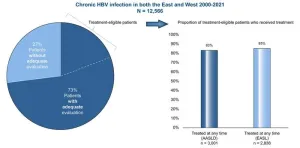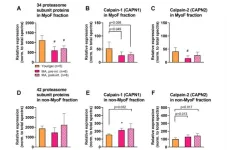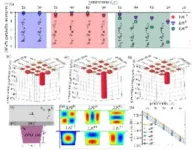(Press-News.org) Global and regional analyses reveal persistent health differences between females and males across the 20 leading causes of disease burden (illness and death—quantified as health loss) over the past 30 years.
Overall, health loss is higher in males, particularly driven by premature death; but females, despite tending to live longer, endure higher levels of illness over their lives—underscoring the diverse and evolving health needs of men and women at different stages of their lives.
These health differences emerge in adolescence highlighting the importance of early interventions and measures to prevent the onset and exacerbation of health conditions.
The authors say that progress towards an equitable and healthy future can only be achieved through concerted, sex- and gender-informed strategies that recognise the unique health challenges faced by men and women at different stages of their lives around the world.
**For regional data, see notes to editors**
Globally, there are substantial differences between females and males (aged 10 and older) when it comes to health, with limited progress in bridging these health gaps over the past 30 years, according to a new study examining the disparities in the 20 leading causes of disease burden between females and males, across ages and regions, published in The Lancet Public Health journal.
Non-fatal conditions that lead to health loss through illness and disability, including musculoskeletal conditions, mental health conditions, and headache disorders, particularly affect females globally, while males are disproportionally affected by conditions that lead to more premature death, such as COVID-19, road injuries, cardiovascular diseases, and respiratory and liver diseases.
Importantly, these health differences between females and males continue to grow with age, leaving females with higher levels of illness and disability throughout their lives, because they tend to live longer than males.
The authors explain that 'sex' refers to the biological and physiological characteristics of females and males, while 'gender' pertains to the socially constructed roles, behaviours, and identities of women and men—as well as gender-diverse individuals—which are also shaped by historical and cultural contexts. These two factors interact, leading to different health and disease experiences among men and women.
The study is a call to action for countries to increase their reporting of sex and gender data and to use these data to overhaul their approach to health. It clearly highlights the need for sex- and gender-informed strategies that recognise the unique health challenges faced by females and males.
The modelling research uses data from the Global Burden of Disease Study 2021 to compare the total number of life years lost to illness and premature death—a measurement known as disability-adjusted life years (DALYs)—for the 20 leading causes of disease in females and males older than 10 years at the global level and in seven world regions, between 1990 and 2021 [1].
The authors note that the analysis does not include sex-specific health conditions, such as gynaecological conditions or prostate cancers, but does examine the health differences between conditions affecting both females and males.
“The timing is right for this study and call to action—not only because of where the evidence is now, but because COVID-19 has starkly reminded us that sex differences can profoundly impact health outcomes”, says senior author Dr Luisa Sorio Flor at the Institute for Health Metrics and Evaluation (IHME), University of Washington, USA. “One key point the study highlights is how females and males differ in many biological and social factors that fluctuate and, sometimes, accumulate over time, resulting in them experiencing health and disease differently at each stage of life and across world regions. The challenge now is to design, implement, and evaluate sex- and gender-informed ways of preventing and treating the major causes of morbidity and premature mortality from an early age and across diverse populations.”
Males face a higher disease burden overall
The analysis estimates that for 13 out of the top 20 causes of disease burden, including COVID-19, road injuries, and a range of cardiovascular, respiratory, and liver diseases, health loss was higher in males than females in 2021 (see figure 2 in paper).
For example, overall COVID-19 was the leading cause of health loss in 2021, with males experiencing 45% more health loss from COVID-19 than females (3,978 vs 2,211 age-standardised DALYs per 100,000). COVID-19 disproportionately affected men in all regions, with the widest sex difference observed in sub-Saharan Africa (10,559 vs 5,565 DALYs per 100,000) and Latin America and the Caribbean (8,124 vs 4,473 DALYs per 100,000).
Ischaemic heart disease had the second largest absolute difference in health loss between females and males, with males experiencing 45% more health loss from heart disease compared to females (3,599 vs 1,987 DALYs per 100,000) in 2021. The greatest difference was seen in Central Europe, Eastern Europe, and Central Asia, where males experienced a 49% higher burden than females (6,789 vs 3,456 DALYs per 100,000).
For conditions with a disproportionate burden in males, such as ischaemic heart disease, lung cancer, and chronic kidney disease, sex differences tend to be small at young ages and widen over the life course. The exception is the disproportionate toll of road injuries on young males (aged 10-24 years) in all world regions.
“Our findings shine a light on the significant and unique health challenges faced by males”, says co-lead author Dr Vedavati Patwardhan from the University of California, San Diego, USA. “Among these challenges are conditions that lead to premature deaths, notably in the form of road injuries, cancers, and heart disease. We need national health plans and strategies to address the health needs of men throughout their lives, including interventions targeting behavioural risks such as alcohol use and smoking that typically begin at a young age.”
The authors stress that progress on health strategies for men has been slow. Globally, new initiatives for men have started to be rolled out, including the 2018 Strategy on the Health and Well-Being of Men in the WHO European Region, which was ratified by over 50 member countries. But to date only a handful of countries (including Australia, Ireland, Iran, Brazil, Malaysia, Mongolia, and South Africa) have designated national-level policies to address men’s health.
Disproportionate toll of disability-causing conditions among females
Among the conditions evaluated, the study suggests that the biggest contributors to health loss globally disadvantaging females are low back pain, depressive disorders, headache disorders, anxiety disorders, other musculoskeletal disorders, Alzheimer’s disease and other dementias, and HIV/AIDS (see figure 2 in paper). These conditions predominantly contribute to illness and disability throughout life as opposed to leading to premature death.
The largest absolute difference in health loss disadvantaging females was seen for low back pain, with DALY rates more than a third higher for females than for males in 2021 (1,265 vs 787 DALYs per 100,000). Regionally, this gap was most pronounced in South Asia, where rates were over 50% higher in females (1,292 vs 598 DALYs per 100,000), and in Central Europe, Eastern Europe, and Central Asia, where female rates were about 30% higher (1,807 vs 1,256 DALYs per 100,000).
Mental health conditions disproportionately impact females in all world regions. For example, health loss caused by depressive disorders was over a third higher among females than males (1,019 vs 671 DALYs per 100,000) globally in 2021, with the widest differences disadvantaging females seen in high-income countries (1,300 vs 747 DALYs per 100,000) and countries in Latin America and the Caribbean (1,139 vs 624 DALYs per 100,000).
For conditions with the greatest gap disadvantaging females, such as mental health conditions and musculoskeletal disorders, the differences in health loss between females and males begin early in life and continue to intensify with age.
“Large causes of health loss in women, particularly musculoskeletal disorders and mental health conditions, have not received the attention that they deserve”, says co-lead author Gabriela Gil from IHME. “It’s clear that women's healthcare needs to extend well beyond areas that health systems and research funding have prioritized to date, such as sexual and reproductive concerns.”
She adds, “Conditions that disproportionately impact females in all world regions, such as depressive disorders, are significantly underfunded compared with the massive burden they exert, with only a small proportion of government health expenditure globally earmarked for mental health conditions. Future health system planning must encompass the full spectrum of issues affecting females throughout their lives, especially given the higher level of disability they endure and the growing ratio of females to males in ageing populations.”
Sex- and gender-responsive approaches to health
These global differences in health loss between females and males have been largely consistent for the past 30 years, but for some diseases, such as diabetes, the difference in DALY rates between females and males nearly tripled between 1990 (56.1 more DALYs per 100,000 among males) and 2021 (142.7 more DALYs per 100,000 among males). At the same time, there has been a disproportionate rise in global health loss caused by depressive disorders, anxiety, and some musculoskeletal disorders disadvantaging females, highlighting that the burden of chronic conditions experienced by females continues to grow.
According to Dr Sorio Flor, “This report clearly shows that over the past 30 years global progress on health has been uneven. Females have longer lives but live more years in poor health, with limited progress made in reducing the burden of conditions leading to illness and disability, underscoring the urgent need for greater attention to non-fatal consequences that limit women's physical and mental function, especially at older ages. Similarly, males are experiencing a much higher and growing burden of disease with fatal consequences.”
She continues, “This kind of critical, comparable, and comprehensive research is important, both to understand the magnitude and distribution of the diverse and evolving health needs of females and males around the world and to identify key opportunities for health gain at all stages of life.”
The authors stress that the health differences identified begin to emerge in adolescence, coinciding with a critical time when gender norms and attitudes intensify and puberty reshapes self-perceptions. This pattern underscores the need for targeted responses from an early age to prevent the onset and exacerbation of health conditions and for adopting a life course approach when planning for health systems so that they are well-equipped to handle the needs of the populations they serve.
Ultimately, unravelling the roots of these health differences by collecting and reporting sex-specific data (and gender identity-specific data when possible) and promoting gender-sensitive research is central to health policy decisions that offer the best opportunities for progress towards an equitable and healthy future for all.
But despite repeated commitments from international and funding agencies, there remain substantial gaps in the availability of sex-disaggregated data. Even for COVID-19, around 60% of countries did not consistently breakdown data by sex. And information on gender identity is even more limited.
Dr Patwardhan adds, “Our analysis also highlights the need for targeted policies and planning to address the health needs of diverse populations. Without granular insights on risk behaviours, social dynamics, economic conditions, and access to health care for all people in various parts of the world, the systemic barriers that sustain health inequities will remain.”
The authors note some important limitations, including that while the study uses the best available data, estimates are constrained by the quantity and quality of past data as well as systemic biases present in epidemiological data—such as recall bias from self-reported data and the under-representation of population groups—which may affect the accuracy of the health differences described. Additionally, the analysis was limited to data on females and males and could not produce estimates for gender-diverse or sex-diverse groups, highlighting the need for more data spanning the sex and gender spectrums. Finally, the study did not include female- and male-specific conditions such as gynaecological diseases and prostate cancers to allow for cross-population comparisons and to highlight areas where sex-and gender-responsive interventions could have substantial health benefits.
Writing in a linked Comment, Professor Sarah Hawkes from the Institute of Global Health, University College London, UK (who was not involved in the study) stresses that too often sex-disaggregated data are overlooked or simply ignored in decision-making processes. She writes, “Even with many decades of empirically robust and rigorous efforts by GBD to report sex differences, we have not seen the same level of attention paid to the question of integrating gender-responsiveness into responses aiming to reduce DALYs or lengthen life expectancy. Yet it is gender—ie, the unequal distribution of power and privilege in the systems and structures determining health and wellbeing—that is determining a large part of the observed health and life expectancy differences between people. It is beyond time in public health politics, policies, programmes, and practices to ensure we move from sex-disaggregation to gender responsiveness that tackles the root causes of health inequities.”
NOTES TO EDITORS
All measures of DALYs included in the press release are the 10+ age-standardised rates reported in the Article.
The study was funded by the Bill & Melinda Gates Foundation. The paper was conducted by researchers at the University of Washington, Seattle, USA and the University of California, San Diego, USA.
[1] The 20 leading causes of disease burden globally for individuals (females and males combined) older than 10 years in 2021 (in descending order of magnitude)—COVID-19; ischaemic heart disease; stroke; chronic obstructive pulmonary disease; diabetes; low back pain; road injuries; depressive disorders; headache disorders; other musculoskeletal disorders; tracheal, bronchus, and lung cancer; cirrhosis and other chronic liver diseases; age-related and other hearing loss; chronic kidney disease; anxiety disorders; falls; tuberculosis; HIV/AIDS; Alzheimer’s disease and other dementias; lower respiratory infections.
The labels have been added to this press release as part of a project run by the Academy of Medical Sciences seeking to improve the communication of evidence. For more information, please see: http://www.sciencemediacentre.org/wp-content/uploads/2018/01/AMS-press-release-labelling-system-GUIDANCE.pdf if you have any questions or feedback, please contact The Lancet press office pressoffice@lancet.com
END
The Lancet Public Health: Global study reveals stark differences between females and males in major causes of disease burden, underscoring the need for gender-responsive approaches to health
2024-05-02
ELSE PRESS RELEASES FROM THIS DATE:
Revealed: face of 75,000-year-old female Neanderthal from cave where species buried their dead
2024-05-02
A new Netflix documentary has recreated the face of a 75,000-year-old female Neanderthal whose flattened skull was discovered and rebuilt from hundreds of bone fragments by a team of archaeologists and conservators led by the University of Cambridge.
The team excavated the female Neanderthal in 2018 from inside a cave in Iraqi Kurdistan where the species had repeatedly returned to lay their dead to rest. The cave was made famous by work in the late 1950s that unearthed several Neanderthals which appeared ...
Hepatitis B is globally underassessed and undertreated, especially among women and Asian minorities in the West
2024-05-02
Amsterdam, May 2, 2024 – New evidence reveals global underassessment and undertreatment of chronic hepatitis B (HBV), especially among women and Asian minorities in the West, a new study in the Journal of Hepatology, published by Elsevier, details.
"In clinical practice we continue to see patients with advanced liver disease due to HBV despite having vaccines for prevention and excellent oral therapy for those who are treatment eligible. Simplifying and broadening HBV management is crucial," according to the researchers.
With the World Health Organization's goal to eliminate viral hepatitis by 2030 fast approaching, targeted outreach is needed to reduce new infections ...
Efficient stochastic parallel gradient descent training for on-chip optical processors
2024-05-01
A new publication from Opto-Electronic Advances; DOI 10.29026/oea.2024.230182 , discusses efficient stochastic parallel gradient descent training for on-chip optical processors.
With the explosive growth of global data volume, space-division multiplexing (SDM) technology has been emerged as a promising solution to enhance the communication capacity. Over the past few decades, SDM has been realized in few-mode fibers, multi-core fiber and free-space optical communication systems. However, all of above solutions face challenges of signal crosstalk because of the mixing between different channels during the ...
Liquid crystal-integrated metasurfaces for an active photonic platform
2024-05-01
A new publication from Opto-Electronic Advances; DOI 10.29026/oea.2024.230216 , discusses liquid crystal-integrated metasurfaces for an active photonic platform.
In the field of optical science, the exploration of metasurfaces has garnered significant attention over the last few decades. Metasurfaces represent a sophisticated evolution of traditional optical components, comprising nanostructures meticulously arranged to enable precise control over light manipulation. These nanostructures function as building blocks, allowing for the creation of lenses with unique ...
Unraveling the efficiency losses and improving methods in quantum dot-based infrared up-conversion photodetectors
2024-05-01
A new publication from Opto-Electronic Science; DOI 10.29026/oes.2024.230029 discusses unraveling the efficiency losses and improving methods in quantum dot-based infrared up-conversion photodetectors.
Traditional infrared imagers are usually constructed by bonding an infrared PD with each pixel of a thin film transistor (TFT)-based active-matrix backplane. A feasible way to avoid the costly pixilation is to use infrared up-conversion photodetector, in which an infrared photodetector (PD) and a light-emitting diode (LED) with large effective areas are back-to-back ...
A novel deep proteomic approach unveils molecular signatures affected by aging and resistance training
2024-05-01
“Resistance training can reverse certain aspects of skeletal muscle aging.”
BUFFALO, NY- May 1, 2024 – A new research paper was published in Aging (listed by MEDLINE/PubMed as "Aging (Albany NY)" and "Aging-US" by Web of Science) Volume 16, Issue 8, entitled, “A novel deep proteomic approach in human skeletal muscle unveils distinct molecular signatures affected by aging and resistance training.”
The skeletal muscle proteome alterations to aging and resistance training have been reported in prior studies. However, ...
High-intensity spatial-mode steerable frequency up-converter toward on-chip integration
2024-05-01
A new publication from Opto-Electronic Science; DOI 10.29026/oes.2024.230036 discusses high-intensity spatial-mode steerable frequency up-converter toward on-chip integration.
Integrated photonic devices consisting of micro-lasers, amplifiers, optical waveguides, frequency converters, and modulators on a single chip, enabling control over photon's spatial modes, frequencies, angular momenta, and phases, are essential for preparing high-dimensional quantum entangled states, high-capacity photon information processing, all-optical communication, and miniaturization of photonic computing. However, ...
Study indicates that cancer patients gain important benefits from genome-matched treatments
2024-05-01
In 2016, The Jackson Laboratory (JAX), a National Cancer Institute-designated Cancer Center and at the forefront of cancer research, launched the Maine Cancer Genomics Initiative (MCGI) to bring the latest progress in cancer care to rural Maine patients. Now, after successfully expanding access to genome tumor testing and targeted cancer treatments throughout Maine, the MCGI team provides compelling evidence that genome-matched treatments can provide significant patient benefit.
The MCGI report, published recently in npj Precision Oncology, ...
Gift to UCR clinic aims to assist local unhoused population
2024-05-01
RIVERSIDE, Calif. -- The Hulen Place Clinic, which UCR Health, the clinical arm of the School of Medicine (SOM) at the University of California, Riverside, opened in September 2023 to address the health and well-being of the unhoused and underserved populations in the County of Riverside has received a gift of $500,000 from the San Manuel Band of Mission Indians, a sovereign American Indian tribe of Serrano people in San Bernardino County, California.
Located about two miles from downtown Riverside and adjacent to an emergency shelter and temporary ...
Research breakthrough on birth defect affecting brain size
2024-05-01
RIVERSIDE, Calif. -- Nonsense-mediated RNA decay, or NMD, is an evolutionarily conserved molecular mechanism in which potentially defective messenger RNAs, or mRNAs (genetic material that instructs the body on how to make proteins), are degraded. Disruption of the NMD pathway can lead to neurological disorders, immune diseases, cancers, and other pathologies. Mutations in human NMD regulators are seen in neurodevelopmental disorders, including autism and intellectual disability.
Why NMD mutations are enriched ...







